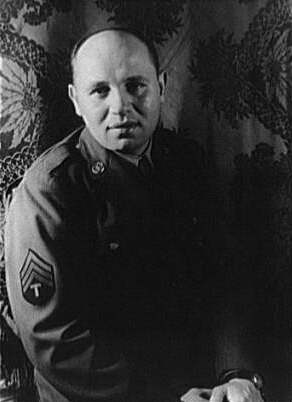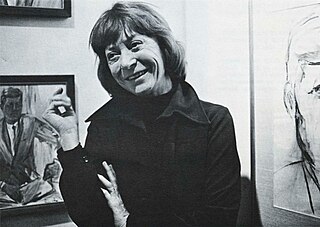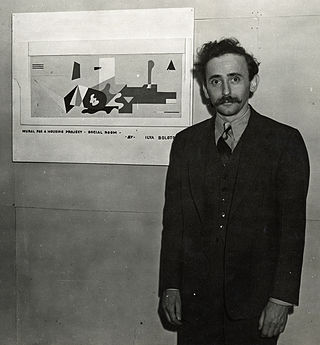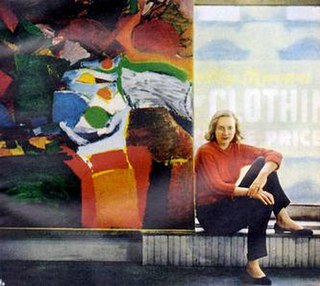Related Research Articles

Kenneth Noland was an American painter. He was one of the best-known American color field painters, although in the 1950s he was thought of as an abstract expressionist and in the early 1960s as a minimalist painter. Noland helped establish the Washington Color School movement. In 1977, he was honored with a major retrospective at the Solomon R. Guggenheim Museum in New York that then traveled to the Hirshhorn Museum and Sculpture Garden in Washington, D.C., and Ohio's Toledo Museum of Art in 1978. In 2006, Noland's Stripe Paintings were exhibited at the Tate in London.

Romare Bearden was an American artist, author, and songwriter. He worked with many types of media including cartoons, oils, and collages. Born in Charlotte, North Carolina, Bearden grew up in New York City and Pittsburgh, Pennsylvania, and graduated from New York University in 1935.

Black Mountain College was a private liberal arts college in Black Mountain, North Carolina. It was founded in 1933 by John Andrew Rice, Theodore Dreier, and several others. The college was ideologically organized around John Dewey's educational philosophy, which emphasized holistic learning and the study of art as central to a liberal arts education.

Josef Albers was a German-born American artist and educator who is considered one of the most influential 20th-century art teachers in the United States. Born in 1888 in Bottrop, Westphalia, Germany, into a Roman Catholic family with a background in craftsmanship, Albers received practical training in diverse skills like engraving glass, plumbing, and wiring during his childhood. He later worked as a schoolteacher from 1908 to 1913 and received his first public commission in 1918 and moved to Munich in 1919.

Lenore "Lee" Krasner was an American painter and visual artist active primarily in New York whose work has been associated with the Abstract Expressionist movement. She received her early academic training at the Women's Art School of Cooper Union, and the National Academy of Design from 1928 to 1932. Krasner's exposure to Post-Impressionism at the newly opened Museum of Modern Art in 1929 led to a sustained interest in modern art. In 1937, she enrolled in classes taught by Hans Hofmann, which led her to integrate influences of Cubism into her paintings. During the Great Depression, Krasner joined the Works Progress Administration's Federal Art Project, transitioning to war propaganda artworks during the War Services era.

Elaine Marie Catherine de Kooning was an Abstract Expressionist and Figurative Expressionist painter in the post-World War II era. She wrote extensively on the art of the period and was an editorial associate for Art News magazine.
Robert Motherwell was an American abstract expressionist painter, printmaker, and editor of The Dada Painters and Poets: an Anthology. He was one of the youngest of the New York School, which also included Willem de Kooning, Jackson Pollock, and Mark Rothko.
The Washington Color School, also known as the Washington, D.C., Color School, was an art movement starting during the 1950s–1970s in Washington, D.C., in the United States, built of abstract expressionist artists. The movement emerged during a time when society, the arts, and people were changing quickly. The founders of this movement are Morris Louis and Kenneth Noland, however four more artists were part of the initial art exhibition in 1965.
Neil Gavin Welliver was an American modern artist, best known for his large-scale landscape paintings inspired by the deep woods near his home in Maine. One of his sons, Titus Welliver, later became a successful actor.
Susan Weil is an American artist best known for her experimental three-dimensional paintings, which combine figurative illustration with explorations of movement and space.

Ilya Bolotowsky was an early 20th-century Russian-American painter in abstract styles in New York City. His work, a search for philosophical order through visual expression, embraced cubism and geometric abstraction and was influenced by Dutch painter Piet Mondrian.

Emerson Seville Woelffer, was an American artist and arts educator. He was known as a prominent abstract expressionist artist and painter and taught art at some of the most prestigious colleges and universities. Woelffer was one of the important people in bringing modernism to Los Angeles, when he taught at Chouinard Art Institute.
Irwin Kremen was an American artist who began making art while Director of the Duke University Graduate Program in Clinical Psychology, when he was 41, after earning a PhD six years earlier in clinical psychology at Harvard University.

Donald Hamilton Fraser RA, was a British artist famed for his abstract landscape paintings.

Mary Caroline Richards was an American poet, potter, and writer best known for her book Centering: in Pottery, Poetry and the Person. Educated at Reed College, in Portland, Oregon, and at the University of California at Berkeley, she taught English at the Central Washington College of Education and the University of Chicago, but in 1945 became a faculty member of the experimental Black Mountain College in North Carolina where she continued to teach until the end of the summer session in 1951.

Grace Hartigan was an American abstract expressionist painter and a significant member of the vibrant New York School of the 1950s and 1960s. Her circle of friends, who frequently inspired one another in their artistic endeavors, included Jackson Pollock, Larry Rivers, Helen Frankenthaler, Willem and Elaine de Kooning and Frank O'Hara. Her paintings are held by numerous major institutions, including the Museum of Modern Art in New York City. As director of the Maryland Institute College of Art's Hoffberger School of Painting, she influenced numerous young artists.

Raymond P. Spillenger was an American painter associated with the New York School.

The Black Mountain College Museum + Arts Center (BMCM+AC) is an exhibition and performance space and resource center located at 120 College Street on Pack Square Park in downtown Asheville, North Carolina dedicated to preserving and continuing the legacy of educational and artistic innovations of Black Mountain College (BMC). BMCM+AC achieves its mission through collection, conservation, and educational activities including exhibitions, publications and public programs.
Mary Lovelace O'Neal is an American artist and arts educator. Her work is focused on abstracted mixed-media and minimalism. She is a Professor Emeritus, University of California, Berkeley and retired from teaching in 2006. O'Neal's art has been exhibited widely throughout North America and internationally, with group and solo shows in Italy, France, Chile, Senegal and Nigeria. She lives and works in Oakland, California, and maintains a studio in Chile.
The Ten, also known as The Ten Whitney Dissenters, were a group of New York–based artists active from 1935 to 1940. Expressionist in tendency, the group was founded to gain exposure for its members during the economic difficulty of the Great Depression, and also in response to the popularity of Regionalism which dominated the gallery space its members sought.
References
- 1 2 Barcena, Bryan (2016). Look Before you Leap Black Mountain College 1933-1957. Institute of Contemporary Art Boston. p. 354.
- ↑ Thompson, James. "Joseph Fiore: Painter/Teacher: Black Mountain College". South Eastern College Art Conference Review. XIV (5): 510–513.
- 1 2 Thompson, James (1995). Joseph Fiore. Black Mountain College Museum + Arts Center. [Black Mountain, N.C.] ISBN 0964902001. OCLC 35308363.
{{cite book}}: CS1 maint: location missing publisher (link) - ↑ "Collection". ASHEVILLE ART MUSEUM. Archived from the original on 2016-03-31. Retrieved 2016-04-08.
- ↑ rachelt (2014-06-23). "Maine Farmland Trust Gifts Works by Joseph Fiore". Maine Farmland Trust. Archived from the original on February 2, 2018. Retrieved April 10, 2016.